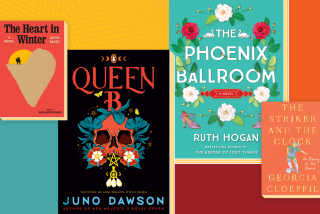In “My Mama Had a Dancing Heart”...
- Share via
In “My Mama Had a Dancing Heart” (Orchard Books: $15.95), a ballerina recalls how the childhood experience of dancing with her spirited mother through a cycle of seasons gave her a dancing heart of her own. Libba Moore Gray’s exuberantly onomatopoeic text dances nimbly past any hint of sentimentality while Raul Colon’s exquisitely colored illustrations have the pointillistic look of a Seurat while evoking a Degas’ sense of graceful movement.
Not the French Impressionists but an American master of mood, Edward Hopper, is the clear inspiration for Barry Root’s watercolor illustrations for “Someplace Else” (Simon & Schuster: $15). Carol P. Saul has written a gently whimsical story of an older woman who, having lived in one place all her life, sets off in search of the perfect somewhere else, only to discover that home truly is wherever the heart is. Root’s accompanying pictures, suffused with the warm colors of a late afternoon in autumn, perfectly capture the elegiac tone of the story.
German Expressionism meets surrealism in Lane Smith’s brilliantly offbeat illustrations for “Math Curse” (Viking: $16.99), the artist’s latest collaboration with supremely zany author John Scieszka. Their story’s premise is simple: An offhand remark by a girl’s teacher--”You know, you can turn almost anything into a math problem”--somehow becomes hilarious reality and transforms the numerically challenged little girl into a self-styled “raving math lunatic.”
Scieszka and Smith’s innovative publisher, Viking, specializes these Postmodern days in mold-breaking, cutting-edge picture books like theirs. Consider, also, “Napoleon” (Viking: $13.99) by brother-sister team Doug and Kim Kennedy. Their eponymous title character is “a crafty little dog” who, to my eyes, looks like a pillowcase filled with jumping beans. On rainy days he likes to play in the attic where he finds all sorts of offbeat objets with which to create a “beautiful mess.” The Kennedys’ scratchy, minimalist pictures are anything but messy, boasting the most expansively uncluttered white space this side of Antarctica.
No picture-book season is complete without contributions by modern masters David Macaulay and Chris Van Allsburg-- unfortunately, their latest respective efforts are relatively modest. In “Shortcut” (Houghton Mifflin: $15.95), Macaulay explores the comedic ramifications of cause and effect. When Albert and his horse, June, elect to take a shortcut to market, their decision sets off a chain reaction involving a number of other unsuspecting travelers. The author-illustrator’s comic-strip style serves his subject well, but he has covered this ground before, and more inventively, in “Black and White” and “Why the Chicken Crossed the Road.”
In “Bad Day at Riverbend” (Houghton Mifflin: $17.95), Van Allsburg, known as an artist who likes to play with perspective, tries a similar strategy as a writer in this story about a dusty Western town whose citizens are plagued by an invasion of “shiny, greasy slime.” The reader quickly discovers that the Riverbendians, starkly rendered in black-and-white outline, are actually--without their knowledge--characters in a child’s coloring book, and that the slime is crayon. The conceit is clever but simply too slender to support an entire book. The result is not intrinsically bad but it lacks the enduring artistry of this two-time Caldecott Medalist’s earlier work.
More to Read
Sign up for our Book Club newsletter
Get the latest news, events and more from the Los Angeles Times Book Club, and help us get L.A. reading and talking.
You may occasionally receive promotional content from the Los Angeles Times.





